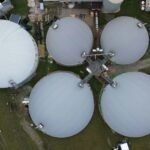Air pollution control in the industry
Webinar recording
Questions and Answers
What is the lifetime of the detection modules, and how do you recycle them – can they be returned and re-conditioned?
The lifetime of the cartridges is two years. What we at Kunak can recycle are the electronic and mechanical components which means that the old cartridges can be returned to our lab and new cartridges are delivered. If interested in the specific recycling process of Kunak cartridges, we can discuss it internally.
Air Quality Innovation in Just 1 Click
Stay informed about the air you breathe!
Subscribe to our newsletter to receive the latest updates on environmental monitoring technology, air quality studies, and more.
The VOCs cartridge, which species is it most sensitive to? It’s an NMVOC sensor?
Kunak VOC cartridge is a total volatile organic compound sensor with a 10.6 eV light energy source to measure accurately the 100s of VOCs commonly found in indoor and outdoor environments. The following table shows a list of the response factors (‘RF’s’) for the different parameters that this sensor can detect.
What’s the detection limit of H2S sensors for WWTP?
The detection limit of the low-concentration H2S sensor is 2 pbb and for the high-concentration H2S sensor is 0.01ppm. The technical specifications of every gas sensor can be checked in our catalogue on page 28.
Does the NH3 cartridge become saturated very quickly, what is its lifetime generally under say agricultural conditions?
We haven’t had saturation issues with the NH3 cartridge thus far. Additionally, the Kunak ammonia sensor is capable of measuring from low to high concentrations with a measurement range from 0 to 50 ppm. In dairy farms, for example, peaks between 8-10 ppm have been detected. Its lifetime is 2 years like the rest of the sensors and its use is mostly for agriculture and compost activities.
Any suggestion for measuring odour in the fertilizer industry?
Based on Kunak’s use cases, these industries are interested in monitoring odours generated by methane (CH4) and ammonia (NH3), key components of their industrial activities. However, every project has its environmental monitoring objective that we can discuss in further and share some of our customers’ experiences.
Are you working to get MCERTS on PM10 and PM2.5? Other sizes?
Yes, we are in conversations with MCERTS to get this certification for PM2.5 and PM10 as indicative measurements.
Can we change the cartridges and perform the calibration by ourselves?
Yes, you can. Our cartridges have a plug-and-play system which makes easy the replacement in situ. Regarding the calibration, we have a tool in our cloud to perform an adjustment of the zero and the sensitivity with only two points: baseline and span. Check our catalogue on page 12 to get more info.
With the MCERTS compliance, is it going to be just for the sensor or for the entire sampling system including the sensor?
MCERTS certification is only for PM sensors, which means that PM2.5 and PM10 will be certified as indicative measurements.
Maximum working temperature?
The maximum operating temperature of our devices is 60ºC and the temperature for the sensors can be checked in our catalogue on page 28.
Can these devices work in a corrosive environment?
We have deployed 80+ devices in different applications with highly corrosive ambients such as terminal ports and industries where the instruments work perfectly fine in the presence for example of 1.000 ppb H2S concentrations. The device’s enclosure is polycarbonate and metallic components are made of stainless steel marine grade. Anyway, we would need more info about the corrosive conditions of the project to determine its feasibility.
My question regarding the sampling system, I mean, for the particulates, is the method of getting the sample to the sensors included in the MCERTS or is the sensor a stand-alone approval?
MCERTS is a certification that approves the particle sensor, as well as all the corrections applied by Kunak, as indicative measurements for PM2.5 and PM10.
What mean to the user “cartridge recondition”?
As mentioned before, the recycling process of Kunak cartridges involves mainly the electronic and mechanical components which means that the old cartridges can be returned to our lab and new cartridges are delivered. No reconditioning process is implemented since for manufacturing every gas cartridge we follow the same quality control and quality assurance lab protocol explained on page 12 in our product catalogue.
Any ideas to integrate 2D sonic into the units in future?
Our instruments can integrate perfectly fine sonic anemometers as external probes.









